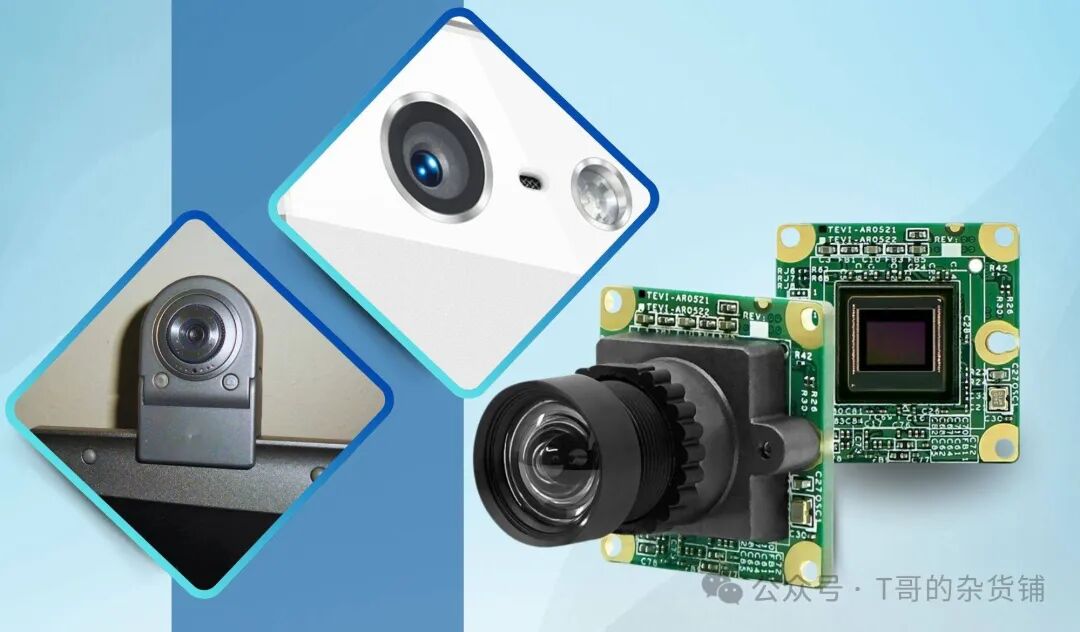MIPI devices address the core pain points of visual robots in multi-sensor fusion, real-time processing, compact deployment, and reliability through high bandwidth, low power consumption, miniaturized design, and standardized protocols.

Introduction
The global robotics market is experiencing rapid growth, with an expected market value of $189.3 billion by 2027[1]. Advances in automation and artificial intelligence visual systems are driving this progress. Robot systems equipped with cameras are key components in this industry, as they can enhance efficiency and accuracy across multiple fields, including manufacturing, healthcare, logistics, and autonomous vehicle development. These systems utilize high-resolution imaging and real-time data processing to perform tasks that require precision and adaptability.
However, despite the immense potential of these systems, several challenges hinder their performance. High latency can reduce operational efficiency; low-resolution imaging can lead to errors in industrial defect detection. Short and inflexible cables, electromagnetic interference (EMI), and high power consumption negatively impact traditional camera systems. These factors affect the functionality and reliability of the systems. To fully realize the potential of robots equipped with visual devices, these challenges must be addressed.

Challenges Faced by Visual Robot Systems
Robot vision systems must overcome various challenges to operate seamlessly in industrial environments. Some of the most common challenges include:
High Latency:
The primary operational issue arises from high latency, which causes delays that affect real-time decision-making processes. Applications such as autonomous navigation systems and robotic-assisted surgeries require rapid decision-making; even a fraction of a second can lead to undesirable outcomes.
Low Resolution:
Another challenge that requires immediate attention is achieving high-resolution imaging capabilities. Using low-resolution cameras in industrial robots significantly increases detection errors, affecting product quality and increasing costs. Compressed image data further reduces clarity, hindering the effectiveness of AI-based defect detection algorithms. For example, the semiconductor manufacturing industry suffers economic losses due to imprecise imaging that results in defective products.
Cable Limitations:
Cable limitations are another significant issue. Transmitting high-resolution images requires high bandwidth, which restricts cable length, resulting in cables that are thick and rigid. These cables limit the mobility of robotic arms and other vision-equipped robots, making installation and maintenance difficult. Traditional cables increase the weight and rigidity of the system, restricting the speed and flexibility needed for robots to adapt to dynamic environments. The demand for 3D camera capabilities in robotic systems also adds complexity to the cabling.
Electromagnetic Interference (EMI):
Electromagnetic interference can also degrade image quality, obstructing AI-driven analysis. Manufacturing environments that utilize multiple electronic devices are easily susceptible to interference, leading to inaccurate object recognition and errors in automation processes, quality control, and safety systems.
High Power Consumption:
High power consumption, especially in battery-powered robotic systems, is also a major concern, as energy-intensive visual systems lead to higher operational costs and sustainability challenges. Addressing these issues is crucial for optimizing the efficiency and reliability of robotic vision applications.
These challenges impact the efficiency and reliability of robotic systems, limiting their potential applications. For industries looking to fully leverage camera-equipped robotic technology, overcoming these issues is essential.
MIPI: The Solution to Visual Robot Challenges

MIPI devices address the core pain points of visual robots in multi-sensor fusion, real-time processing, compact deployment, and reliability through high bandwidth, low power consumption, miniaturized design, and standardized protocols. As the MIPI protocol evolves towards automotive-grade safety standards (such as ISO 26262), its application prospects in autonomous driving and industrial robotics will become even broader.
Recommended Reading: MIPI Standard Explanation
Multi-Sensor Fusion and High Bandwidth Requirements
Visual robots often need to integrate multiple sensors, such as cameras, LiDAR, and infrared. The MIPI CSI-2 protocol supports multi-channel data transmission (e.g., 4-channel D-PHY v2.1 can reach 18Gbps, C-PHY v2.0 can reach 44.5Gbps), enabling simultaneous processing of multiple high-resolution image data. For example, in autonomous driving scenarios, it is necessary to fuse data from cameras, radar, and ultrasonic sensors. MIPI’s virtual channel technology can distinguish different sensor signals, enhancing perception accuracy. Additionally, the flexibility of MIPI interfaces supports multi-camera stitching (e.g., in drone projects, 4 MIPI inputs can be stitched into 2 outputs), reducing hardware complexity.
Low Power Consumption and Energy Efficiency Optimization
Visual robots are sensitive to power consumption, especially in mobile scenarios. MIPI D-PHY uses low-voltage differential signaling (LP mode has extremely low power consumption), combined with C-PHY’s efficient encoding technology, significantly reducing transmission energy consumption. For example, NXP’s MCX series MCUs integrate NPU and MIPI interfaces, optimizing edge computing to lower overall power consumption. Furthermore, MIPI’s dynamic clock control (activating the clock only during high-speed transmission) further reduces standby power consumption.
Miniaturization and Compact Design
The physical layer design of the MIPI interface (e.g., differential signal pairs of D-PHY) reduces the number of pins and PCB area, making it suitable for the miniaturization needs of embedded devices. For instance, in drone projects, a single chip can achieve 4 MIPI inputs, saving 50% of FPGA resources. At the same time, the standardized protocol of MIPI CSI-2 simplifies the connection between sensors and processors, avoiding complex adapter circuits.
Real-Time Performance and High Frame Rate Support
Visual robots need to process image data quickly to complete tasks such as obstacle avoidance and navigation. MIPI supports high-speed transmission modes (e.g., CSI-2 can reach 6Gbps), combined with NPU acceleration (e.g., NXP i.MX8M Plus with 2.3TOPS computing power), achieving real-time image processing at over 40 frames per second. For example, industrial robots can transmit 4K resolution images via MIPI interfaces and achieve low-latency processing through FPGA.
Recommended Reading: Capturing Every Moment: The Magic of FPGA in Photography
Reliability and Safety
In automotive and industrial scenarios, the MIPI protocol complies with ISO 26262 functional safety standards, supporting data verification and error correction (e.g., pixel loss detection in CSI-2 4.0), ensuring the integrity of sensor data. Additionally, Megvii’s patented MIPI technology enables flexible switching of signal channels through FPGA, enhancing the stability of data readback.
Recommended Reading: The Use of MIPI A-PHY 2.0 in Automotive Electronics
Compatibility and Scalability
The wide compatibility of MIPI interfaces lowers the development threshold. For example, mainstream embedded platforms such as NVIDIA Jetson and NXP i.MX integrate MIPI interfaces, supporting plug-and-play functionality. Additionally, MIPI supports scalability from consumer-grade to automotive-grade (e.g., AEC-Q100 certification), meeting the needs of different scenarios.

MIPI Application Cases
Humanoid Robots:
Humanoid robots equipped with high-resolution cameras require lightweight image processing capabilities to frequently perform complex tasks such as navigation and object manipulation. Using MIPI SerDes integrated circuits allows these robots to operate with higher precision and responsiveness in industrial and healthcare settings. These integrated circuits help humanoid robots improve interactions with humans in elderly care applications in service robotics and healthcare.
Surgical Robots:
In medical robotics, minimally invasive surgeries require ultra-high-definition imaging. MIPI SerDes ICs can transmit real-time images, providing surgeons with clear and precise visual feedback during procedures. This greatly enhances accuracy and patient safety, especially in delicate surgeries such as neurosurgery or robotic-assisted laparoscopic surgery.
Factory Automation and Quality Control:
Manufacturing plants are now utilizing high-tech visual systems specifically designed to identify small defects, ensuring product quality. This system combines high-definition imaging with AI analysis, making even the smallest flaws detectable. The MIPI SerDes IC acts as a data transmission expert, making our automated inspection systems more accurate and reliable. As a result, production efficiency increases, material waste decreases, saving money and being environmentally friendly—achieving two goals at once!

Automated Guided Vehicles (AGV)
AGVs are crucial for logistics and warehouse automation, as real-time navigation and obstacle detection are essential. High-speed image transmission enables AGVs to move efficiently, reducing collision risks and improving overall workflow efficiency.
Recommended Reading: The New Revolution in Smart Logistics: The Battle Between AGVs and AMRs, Who Will Prevail?
Collaborative Robots (Cobots)
Imagine cobots as your super work partners, able to work alongside you, boosting your work efficiency, precision, and safety. These little guys need to observe their surroundings in real-time and react quickly, relying on ultra-fast data transmission and instant processing capabilities. In this regard, silicon integrated circuits, especially MIPI SerDes integrated circuits, act as their super brains, providing robots with high-definition vision, rapid response times, and low power consumption. With these, cobots can excel in fields that require high precision and flexibility, such as manufacturing, healthcare, and logistics!
Recommended Reading: Exploring Future Work Partners: Cobot Collaborative Robots, Ushering in a New Era of Intelligent Collaboration!
Conclusion
Visual robot systems are sweeping across various industries, but issues such as high latency, low resolution, inflexibility, and short transmission distances often limit their performance. However, the rapid development of semiconductor technology, particularly MIPI SerDes integrated circuits, has fundamentally transformed the performance of visual robot systems. These innovative technologies address some of the major problems of traditional systems. They significantly increase data transmission speeds, enable real-time image processing, and make operations more energy-efficient, thus elevating the performance and reliability of robots across nearly all fields.
The continuous advancement of semiconductor technology will determine the future direction of robotics. Developing ultra-low-power integrated circuits, AI-optimized processors, and edge computing solutions will further enhance the autonomy and efficiency of robotic systems. Moreover, integrating 3D imaging, hyperspectral vision, and neuromorphic computing can enable robots to perceive and interpret their surroundings more accurately.
As various industries move towards intelligent automation, the combination of the latest integrated circuits and AI-driven robotic technologies will bring forth more advanced, flexible, and sustainable solutions. These innovations will expand the capabilities of camera-based robotic automation, reshape the future of the robotics and automation industry, and enhance productivity, safety, and operational efficiency across various sectors.
References
[1] Advantech, “Achieving Intelligent Robotics with Single Board Computing”.
[2] P. Lu, K. Yuan, and W. Zou, “A High-Performance, Low-Power Robot Vision System”, Proceedings of the Third International Conference on Natural Computation (ICNC 2007), Volume 5, IEEE, August 2007, pp. 171-175, doi:10.1109/ICNC.2007.42.
ClickFollow,Make Friends

 THE END
THE END
The content represents the author’s personal views, and unauthorized reproduction is prohibited.
The opinions and data in this article are for reference only; any commercial use based on this is at your own risk.
If there are any violations or infringements, please send a private message for deletion.
Sharing, liking, and showing love are all encouragement!